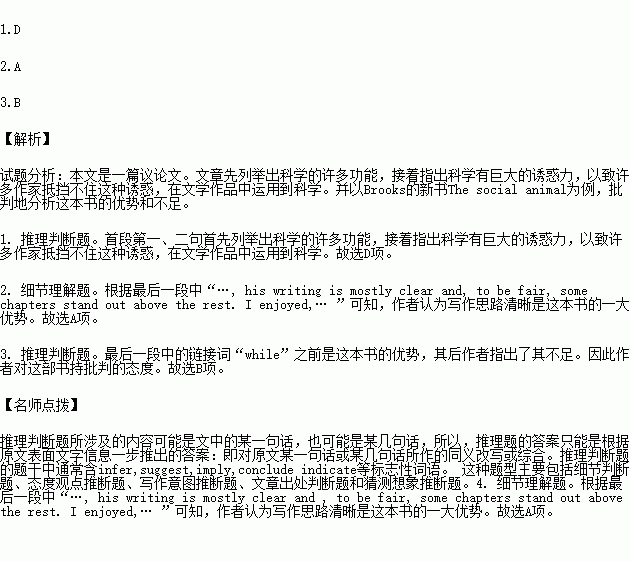题目内容
Science has a lot of uses. It can reveal (揭示) laws of nature, cure diseases, make bombs, and help bridges to stand up. Indeed science is so good at what it does that there’s always a temptation (诱惑) to drag it into problems where it may not be helpful. David Brooks, author of The Social Animal, The Hidden Sources of Love, Character, and Achievement, appears to be the latest in a long line of writers who have failed to resist the temptation.
Brooks gained fame for several books. His latest book The Social Animal, however, is more ambitious and serious than his earlier books. It is an attempt to deal with a set of weighty topics. The book focuses on big questions: What has science revealed about human nature? What are the sources of character? And why are some people happy and successful while others aren’t?
To answer these questions, Brooks surveys a wide range of subjects. Because of this, you might expect the book to cover a variety of facts. But Brooks has structured his book in an unusual, and perhaps unfortunate way. Instead of introducing scientific theories, he tells a story, within which he tries to make his points, perhaps in order to keep the reader’s attention. So as Harold and Erica, the hero and heroine in his story, live through childhood, we hear about the science of child development and as they begin to date we hear about the theory of sexual attraction. Brooks carries this through to the death of one of his characters.
On the whole, Brooks’s story is acceptable if uninspired. As one would expect, his writing is mostly clear and, to be fair, some chapters stand out above the rest. I enjoyed, for instance, the chapter in which Harold discovers how to think on his own. While Harold and Erica are certainly not strong characters, the more serious problems with The Social Animal lie elsewhere. These problems partly involve Brooks’s attempt to translate his tale into science.
1.The author mentions the functions of science at the beginning of the passage to ________.
A. show the value of Brooks’s new book
B. show where science can be applied
C. remind the reader of the importance of science
D. explain why many writers use science in their works
2.According to the author, which of the following could be a strength of the book?
A. Its clear writing.
B. Its convincing points.
C. Its strong characters.
D. Its strong basis.
3.What is the author’s general attitude towards the book?
A. Cautious.
B. Critical.
C. Contradictory(矛盾的).
D. Supportive.

